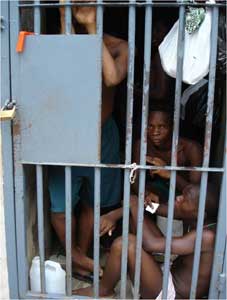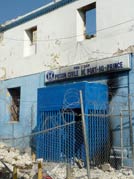Haiti recovery efforts should include prisons
November/December 2010 | Volume 9, Issue 6

Photo courtesy of Health Through Walls
The just treatment of prisoners in Haiti is
central to the nation's recovery, argue
health experts.
The humane detention of prisoners, including provision of medical care, is crucial to Haiti’s recovery from the devastating 2010 earthquake, according to Dr. Jean Pape, Fogarty grantee and director of GHESKIO. In a recent issue of Annals of Internal Medicine, Pape and a group of physicians working on a prison health care program issued a call to action, emphasizing that the just treatment of inmates is essential to Haiti’s reconstruction.
“Internationally, resources typically fail to reach prisoners, in part because of the diminished value placed on prisoners’ lives, yet failure to meet the needs of prisoners has public health consequences,” said Pape and his co-authors. “Distributing health resources according to a system based on disparate value of human life disrupts and defeats control of infectious diseases.”

Photo courtesy of
BBC World Service
Haiti's largest
penitentiary, the Prison
Civile, was badly
damaged in the January
2010 quake.
Thousands of prisoners in Port-au-Prince who’d been receiving much-needed medical care fled when the massive quake struck Haiti in January 2010. Six male inmates were killed and the nation’s largest penitentiary, the Prison Civile, was badly damaged. The surviving men escaped, though many had been receiving care for a wide range of serious conditions. The treatment was being provided under a new program funded by the nonprofit organization Health Through Walls and USAID. The primary intervention focused on the Prison Civile, with the hope that it would eventually serve as a model for the nation’s other prisons.
The facility, about 100 years old and designed for 800 occupants, housed more than 4,200 inmates when the quake hit. The prison had a long history of deaths resulting from malnutrition and preventable infectious diseases. Most prisoners lived under brutal conditions, packed together in small rooms. The intervention program had just begun to make inroads in addressing their health care needs when the disaster struck.
Pape and his colleagues are urging the international community to address this issue when planning relief efforts.
“Recovery for postearthquake Haiti, as any nation rebuilding following natural disaster or conflict, requires respect for rule of law,” they argue. “This includes humane detention and the delivery of justice and adequate health care for prisoners.”
Health Care for Prisoners in Haiti, Annals of Internal Medicine, 21 Sept. 2010, pgs. 407-10.
To view Adobe PDF files,
download current, free accessible plug-ins from Adobe's website.